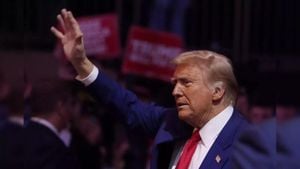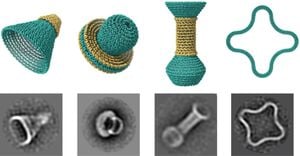Photography and fashion are often viewed as realms dominated by mainstream narratives, yet there has long been a quiet revolution occurring within them—one aimed at eleviating Indigenous representation. Artists and designers of Indigenous descent are not merely reclaiming space; they're reshaping how their cultures and narratives are perceived globally. This movement is gaining traction, allowing the richness of Indigenous cultures to spill over the traditionally defined borders of various art forms.
Joe Whittle, an Indigenous photographer hailing from the Caddo Nation, is among those leading the charge. With more than 25 years of experience behind the lens, Whittle's work focuses on capturing the connection between Indigenous peoples and their landscapes. He likens the stories of his ancestors to the very elements of nature, noting how their histories are intricately woven with the land they inhabit. “The original stewards of the land are still its best stewards today,” he asserts, embodying the ethos of reciprocity inherent to many Indigenous cultures.
One of Whittle’s most poignant projects documents the deep bond Native American communities maintain with their ancestral lands, emphasizing the stewardship role these communities have played for millennia. During the tumultuous period of Native American Heritage Month, Whittle’s work serves as both tribute and reminder of the often invisible threads tying Indigenous identity to the environment.
His subjects range from quiet moments—such as Native children collecting medicinal plants by the shores of Caddo Lake—to pivotal historical events, like the Dakota Access Pipeline protests, where Indigenous activists gathered to protect sacred waters. Each photograph is imbued with stories from the past, present, and aspirations for the future.
Whittle’s imagery shines light on the struggles and victories of Indigenous communities, showing how they have been at the forefront of asserting their rights to both the land and its resources. Highlighting figures like Glenna Begay, a Diné elder tending to her sheep against the backdrop of Black Mesa, he showcases living embodiments of resilience. Begay’s home, established without modern amenities, stands as resistance against systematic displacement, underscoring the tenacity with which Indigenous peoples fight to maintain their heritage.
The visual narratives captured by Whittle also draw attention to broader ecological issues, linking Indigenous existential struggles with global environmental challenges. He advocates for Indigenous-led land management as a pivotal step toward ecological restoration; returning land to its original stewards can shift public lands from being polluters to carbon sinks.
This artistic revival of Indigenous culture isn’t confined to photography alone. The fashion industry is waking up to the need for authentic representation. Designers with Indigenous backgrounds are infusing their collections with the stories, materials, and motifs characteristic of their cultures, challenging the fashion status quo. Designers like Virgil Ortiz, who employs ancestral pottery techniques and symbolism, are shaking up runway aesthetics, bridging ancient craftsmanship and contemporary fashion.
Fashion, when rooted deeply within cultural relevance, has the power to educate consumers about Indigenous histories and the importance of representation. Ortiz’s works, for example, pay homage to the Pueblo culture, offering insight not only through garment design but through storytelling.
Yet elevatin Indigenous fashion isn’t merely about aesthetics; it necessitates ethics and authenticity, too. Critics often point out the risk of cultural appropriation when non-Indigenous designers draw inspiration from Indigenous aesthetics without proper acknowledgment or systems of partnership. The push for inclusivity means ensuring Indigenous creators are part and parcel of the narrative, standing behind their designs and stories.
The combination of photography and fashion as mediums for documenting and uplifting Indigenous stories is powerful, but it also bears the responsibility of historical and cultural accuracy. Recognizing this, call for more collaborative opportunities between Indigenous artists and platforms across the broader art and fashion worlds is growing stronger.
Moments during Indigenous Peoples' Day celebrations and fashion shows serve to bridge these artistic expressions. Exhibitions featuring Whittle and other Indigenous photographers have begun to incorporate runway elements, showcasing the symbiotic relationships between the different art forms. This fusion also opens doors for fresh dialogues surrounding representation, as audiences can engage with both the visual and experiential aspects of Indigenous identity.
Whittle’s approach extends the conversation beyond traditional gallery spaces, allowing sacred Indigenous stories to breathe within contemporary settings. “Art must remain relevant; it’s how cultures survive,” he explains. If art serves as the lifeblood of culture, fashion and photography offer new veins through which Indigenous narratives can invigorate and thrive.
The images featured within Whittle's projects not only capture the essence of Indigenous existence but also challenge preconceived notions surrounding art consumption. They tell tales of resilience, survival, and hope for future generations. They reflect the very spirit of Indigenous identity—deeply connected to the Earth, rich with history, and unwaveringly steadfast.
Going forward, the coalition of photographers and designers will undoubtedly pave the way for even more expansive dialogues surrounding representation and authenticity. The momentum is undeniable; the demand for greater visibility and inclusivity within photography and fashion continues to rise. Whether through art, design, or sheer activism, the message is clear: Indigenous voices must not only be heard, but celebrated.
There’s much work left to be done, but as showcased through the efforts of individuals like Whittle and others within the fashion industry, progress is taking form. These creative outlets have opened up the floor for Indigenous voices—creating spaces where stories aren’t just told, they are felt. A collective push for visibility is revitalizing conversations on land rights, cultural history, and environmental sustainability, reminding us of the power of diverse representation.



